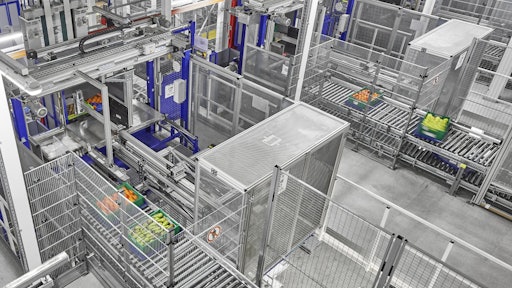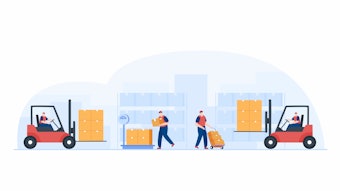
Market trends have shifted over the last decade in a big way toward e-commerce. As online sales have grown, the demand is driving much of the developments related to warehouse automation and altering the way companies handle order fulfillment, industry suppliers say.
“The lead times and order profiles are becoming more and more aggressive with shorter fulfillment windows and quicker delivery times,” says Michael Pietras, executive sales manager at SSI Schaefer Systems. “Customers are creating the need for larger stock selection, more unique item offerings and more convenience.”
Pietras says tech and retail giants such as Amazon and Walmart have changed the landscape and, as a result, affected how automation providers adapt solutions to the market.
“It used to be that we were fulfilling orders for items going to retail establishments,” Pietras says. “More and more the shift is going direct to customers. Instead of an order of several cases of a particular product going to a store, now it’s a single piece or a couple of pieces going directly to a customer. Lead times are cut to 24 to 48 hours to get it to the customer, meaning the number of packages and orders to be fulfilled has increased dramatically. To do that fulfillment, the engines in the automation space have to be more robust and more intelligent.”
E-commerce and Adaptability
Tom Rentschler, head of marketing, Americas, for Swisslog Logistics Automation, notes that the market is shifting away from what has traditionally been considered warehouse automation. An earlier wave of automation was primarily mechanization featuring systems with miles of conveyers, sortation systems bolted to the floor, and long lead times designed for a well-defined volume of throughput. The reason those systems were popular is that most companies could reliably predict the growth of their business.
“What’s disrupted that, and what’s caused the adoption of true automation, is the explosion of e-commerce,” Rentschler says. “It’s the fastest-growing segment of the U.S. economy and elsewhere in the world. E-commerce introduced extreme unpredictability, which proved problematic for mechanized distribution centers and their fulfillment of orders. Most companies did a poor job of understanding the effect that the growth of e-commerce was going to have on their business. We have seen retail businesses, in some cases, wiped out or lose shareholder value. The mega-trend is for flexibility and scalability for both distribution systems and automated warehouse systems. The key is adaptability, how to adapt to changing demand, whether it’s up or down.”
"There is growing demand in micro fulfillment for grocery chains, providing an evolutionary online grocery shopping experience for customers."
Evolving Trends, Greater Sophistication
Norman Leonhardt, director of business development at Witron, says there is a new trend in automation every year, but not all are developed. Last year it was automatic truck loading; this year it is micro-fulfillment centers. He says robotic picking may become a trend at some point.
“There are a lot of partial solutions that do not fully satisfy customer needs,” he says. “Anything that’s reliable and eliminates high labor costs is the next step in warehouse automation. Another trend is on the packaging side. Packaging is more designed for the customer, with transparent packaging or shiny images of the product. As we see online ordering increase, there’s less relevance in package appearance or in-store displays. Therefore, packaging could be more conducive to robotic picking.”
Pietras recalls that 10 or 15 years ago, automated technology catered to trains and carousels, which are still reliable for certain markets. However, e-commerce has driven a shift toward shuttle systems, matrix systems and pocket rotation systems.
“From our side, the main focus is providing hardware that supports these large systems, and the software that manages the orders,” he says.
For example, Pietras points to a recent e-commerce warehouse automation installation. A customer in the apparel industry wanted to grow its e-commerce channel and design a building to house 1 million SKUs, handle 1 million units per day during its peak season and fit it all into 1 million square feet.
“Traditional solutions in automation would move specific pieces to a specific tote and then route that tote to shipping,” Pietras says, “but when you’re moving a million units a day, the number of packages going out would be too much for the system. Whether it’s the workstations or the conveyance around the workstations, or supporting the infrastructure of the system, you need to get more intelligent with how you fulfill orders.
“So, the next logical step would be to do a pick and sort, where items would go into batches of totes for order consolidation. That reduces the number of packages going out at one time and allows you to fulfill more orders in a shorter time frame. The issue with pick and sort options is that you have to pick, sort, consolidate and pack—four touches. The next advancement in the revolution of automation would be to go to a system that allows only two touches and still does fulfillment.”
Pietras says SSI Schaefer’s solution was to go to an “uber head” sortation system and consolidate the number of touches from four down to two.
“We implemented a large shuttle system that did pick and sort, and now we are working on what we call pocket sort and pack. That’s where we stand today.”
Pietras says there is growing demand in micro fulfillment for grocery chains, providing an evolutionary online grocery shopping experience for customers. The apparel industry, also faced with shorter lead times, is another big driver, as is the pharmaceutical sector. The challenges ahead include continually adapting to changing demands, either from the economic or customer landscape, and the way technology drives society.
“We have more conveniences that have become an integral factor to customers,” Pietras says. “We need to keep up with changing trends and how technology affects customers—how they interact with each other, how they interact with products, and how they acquire products.”
Software Takes the Lead
Rentschler says that software has become almost more important than hardware. Hardware to some degree has been commoditized. All of the major providers of material handling automation have similar systems and the performance characteristics of those systems are not all that different.
“It’s very unusual for one company to have a true technological edge over another,” says Rentschler. “What’s really differentiating is the software, and the ways that it can orchestrate the movement of product and process and people—together into one well-oiled machine. The hardware is a big part, but the software is really the brains. It’s how operators can mine not just data but intelligence out of their systems.”
Rentschler says with the advent of Industry 4.0, because of the sensors that are placed throughout distribution centers, there is an ability of subsystems and software to communicate in real time.
“We’re heading toward systems that can self-optimize. The system will understand how to improve itself because of the continuous communication that is taking place from the equipment level up through the host WMS ERP,” he says.
Swisslog is owned by German robotics manufacturer, Kuka, which makes robots primarily for manufacturing.
"We’re heading toward systems that can self-optimize. The system will understand how to improve itself because of the continuous communication that is taking place from the equipment level up through the host WMS ERP."
“We are starting to bring robots into picking operations in warehouses,” Rentschler says. “By combining the Kuka robot arm with a customized vision system, it can pick an item the same way a human could. It is able to recognize and pick different items. That’s a way for companies to augment and address the labor shortage that everyone is faced with right now.”
Grocery chains are really looking at automation for their new trend of e-grocery fulfillment. A lot of these companies are doing a combination of curbside delivery and home delivery, and all the major chains are looking into how to automate that unit of operation as it grows.
“We’ve got systems that are being implemented for a major grocery chain. It’s probably the hottest segment of the industry right now—e-grocery or micro fulfillment,” Rentschler says. “Some grocery chains are thinking about putting actual automation inside the store, keeping the fresh items around the perimeter of the store, but in the center have fulfillment of non-perishables and hard goods with something like an Autostore in the middle of the store.”
Leonhardt says developing fully-automated warehouses have become Witron’s bread and butter the last few years.
“This is a warehouse where there is no touch necessary, the only time anyone is touching any product is when something gets stuck on the conveyer belt,” says Leonhardt. “Operations managers will correct some faults. Sometimes there needs to be some kind of manual de-palletization to remove product in poor condition. All the steps from receiving to shipping are automated. It’s our main technology, called order picking machinery (OPM), along with our multiple other technologies for piece picking, traditional catalog fulfillment and now e-commerce fulfillment.”
Leonhardt says many of Witron’s customers are looking at automation as a way to achieve labor reduction.
“Companies are looking for the accuracy of the picking, to make sure at least 99.9 percent of the shipments are correctly done,” he says. “A lot of companies are seeking to change packaging. Nowadays it seems like we are shipping a lot of air, because small packages get put into bigger packages. That is another factor people are looking for right now.
“Transparency throughout the supply chain is another. To know where item “x” is right now. Is it at the supplier, is it at the warehouse, or is it on the way to the customer? If an item is not at the store to be picked up, when can it be at the store, when is the next delivery of these items happening? Knowing that data is a major factor nowadays.”






























